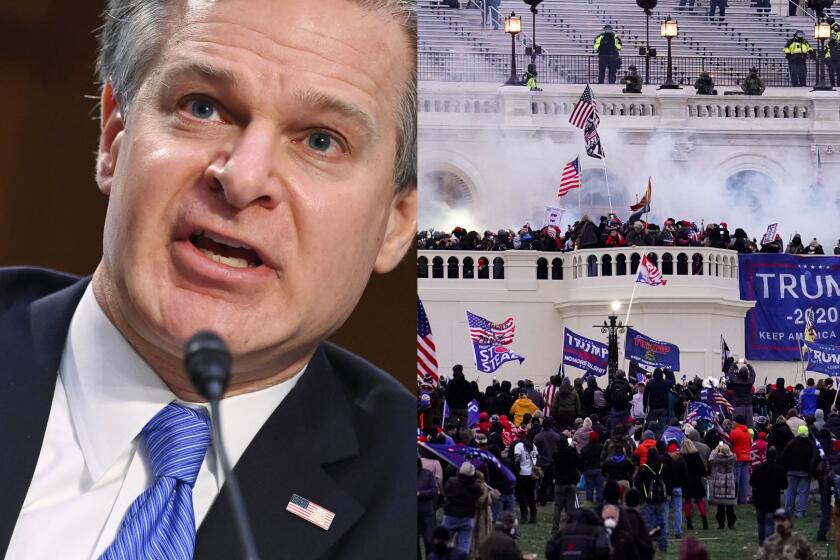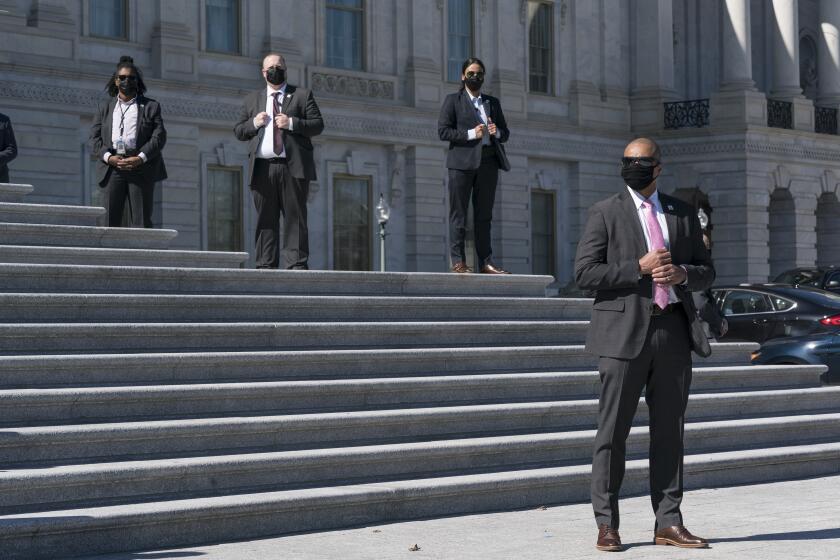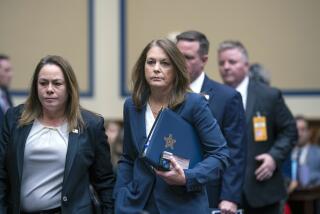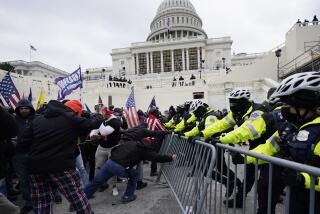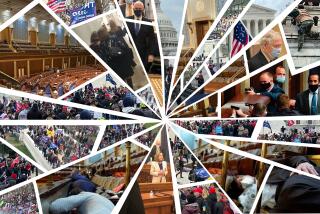Capitol riot: D.C. Guard chief testifies he was ‘stunned’ he had to wait hours to send troops
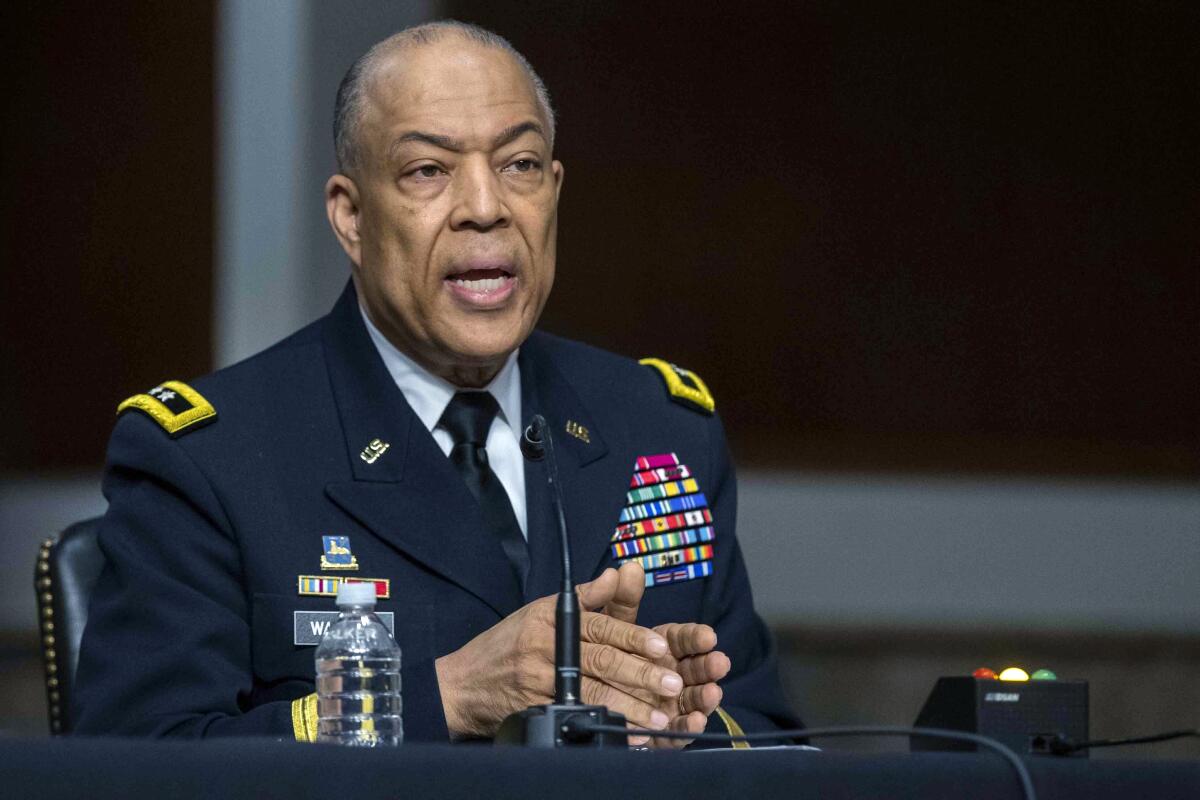
- Share via
WASHINGTON — The Pentagon took more than three hours to dispatch National Guard troops to help quell the Jan. 6 siege of the U.S. Capitol even as police pleaded for assistance in repelling the pro-Trump mob, the commander of the D.C. National Guard testified Wednesday before Congress.
Maj. Gen. William J. Walker said that he had received a “frantic” call from then-Capitol Police Chief Steven Sund at 1:49 p.m. that day seeking his help amid the growing riot, one that would leave five people dead — including a Capitol Police officer — and dozens of other officers injured.
“Chief Sund, his voice cracking with emotion, indicated that there was a dire emergency on Capitol Hill and requested immediate assistance of as many guardsmen as I could muster,” Walker said.
The National Guard had about 150 soldiers in the area, Walker said, that he could have quickly sent to the Capitol. But the commander said he was not allowed to deploy his troops without permission from top Defense Department officials.
It took more than three hours to obtain their assent, he testified, far longer than in the summer when the Trump administration cracked down on racial justice protests and unrest. On Jan. 6, Walker’s first soldiers did not reach the Capitol grounds until about 5:20 p.m.
“I would have sent them there immediately,” Walker said. “That is where the fire was, and it needed to be put out.”
FBI Director Christopher Wray defends the bureau’s actions days before a pro-Trump mob stormed the Capitol in a deadly insurrection.
Walker joined three other national security officials appearing at a joint hearing before the Senate Rules and Homeland Security committees, among several congressional panels investigating what transpired Jan. 6 when a pro-Trump mob stormed the Capitol to prevent the certifying of electoral votes to formalize Joe Biden as winner of the presidency.
In addition to congressional inquiries, the Justice Department has launched a wide-ranging inquiry and has arrested nearly 300 people on charges stemming from the riot. On Tuesday, FBI Director Christopher A. Wray called the Capitol siege an act of “domestic terrorism.” He said that his agency had about 2,000 open domestic terrorism investigations, up significantly from a year ago, and that his agency was scrambling to get its hands around what he described as a “metastasizing” problem.
Federal agents and lawmakers are trying to piece together how hundreds of rioters — many with radios, climbing gear, protective vests and weapons — managed to elude detection by the nation’s premier law enforcement and intelligence agencies. Lawmakers are also trying to figure out why it took so long for reinforcements to arrive to help police, who were outnumbered and overwhelmed.
Sen. Gary Peters (D-Mich.), chairman of the Senate Homeland Security Committee, said he and other lawmakers “need answers about the operational failures that terrible day, especially the response to secure the building once it was breached.”
The hearing came as thousands of National Guard troops are still patrolling the fortified Capitol, and officials remain on high alert for potential violence from right-wing extremists angry that President Trump lost the election.
Capitol Police officials issued a statement Wednesday saying they “have obtained intelligence that shows a possible plot to breach the Capitol by an identified militia group” on Thursday, the day on which some right-wing conspiracy theorists hope Trump will return to power. House leaders moved a vote from Thursday to Wednesday night so members would not need to appear. It appeared the Senate would not cancel its Thursday session.
The U.S. House is abruptly finishing its work for the week given the threat of violence at the Capitol by a militia group seeking to storm the building.
At Wednesday’s hearing, senators zeroed in on delays Walker faced in trying to dispatch troops to the Capitol, and they contrasted those setbacks with what the commander experienced months earlier. Walker testified that he received approval “within minutes” last year to deploy during racial justice protests.
He could not explain why there was such a long delay on Jan. 6.
“It’s an elaborate process, but it doesn’t always have to be. ... We can get it done over the phone,” he said.
Walker said he was particularly irked by Army leaders’ reaction to pleas for help from Sund, the Capitol Police chief at the time. During a 2:20 p.m. phone call, as the Capitol was being breached, Sund asked Army officials to permit Walker to send his troops.
Army officials balked, explaining that they did not like the optics of having uniformed troops on the Capitol grounds, according to testimony last week from Sund and Washington Police Chief Robert J. Contee III.
Walker said that the Army leaders on that call — including Lt. Gen. Charles Flynn, the brother of Trump’s fired national security advisor Michael Flynn — told Sund that “it would not be their best military advice to the secretary of the Army to have uniformed guardsmen on the Capitol.”
“I was just as stunned as everyone else on the call,” Walker said.
An Army spokeswoman did not immediately respond Wednesday to a request for comment from Flynn and another Army leader, Lt. Gen. Walter Piatt, who was also on the call. The Army declined last week to address the allegations by Sund and Contee and issued a statement that the Pentagon’s inspector general “is now reviewing the details of the preparation for and response to the Jan. 6 protest and attack on the U.S. Capitol. We intend to allow that process to proceed independently.”
Robert G. Salesses, a top Pentagon official, testified Wednesday that on Jan. 6, then-acting Secretary of Defense Christopher Miller at 3 p.m. authorized the full activation of the D.C. National Guard. About 90 minutes later, after hashing out the details about the Guard’s mission, Miller approved deployment of the troops to the Capitol.
Under questioning from Sen. Roy Blunt (R-Mo.), Salesses said he could not explain why Army leaders took 40 more minutes to alert Walker that he was cleared to dispatch his troops.
“That’s an issue,” Salesses said.
Walker testified that after his first call with Sund, he began getting ready to deploy his forces. He summoned about 150 troops to an armory, had them put on their gear and loaded them onto buses.
“At that point, seconds mattered, minutes mattered, needed to get there as quickly as possible,” he said. Once approval arrived, Walker said, his soldiers reached the Capitol in about 20 minutes.
Salesses and Walker both testified that in the days leading up to the Jan. 6 assault, local D.C. officials, federal law enforcement authorities and Capitol Police requested National Guard help only to control traffic, not protests.
Walker also complained about what he described as “unusual” restrictions on his ability to deploy his forces. He needed specific authorization from the Pentagon’s leadership, for example, to supply his troops with protective gear or to shift them to a different street corner.
Salesses testified that military officials issued such restrictions because they were “mindful of observations and lessons learned” from criticism of how the Trump administration deployed troops in response to civil unrest. Activists and local officials have decried what they described as the Trump administration’s heavy-handed tactics last year in breaking up protests, particularly a peaceful one near the White House.
More to Read
Get the L.A. Times Politics newsletter
Deeply reported insights into legislation, politics and policy from Sacramento, Washington and beyond. In your inbox three times per week.
You may occasionally receive promotional content from the Los Angeles Times.
